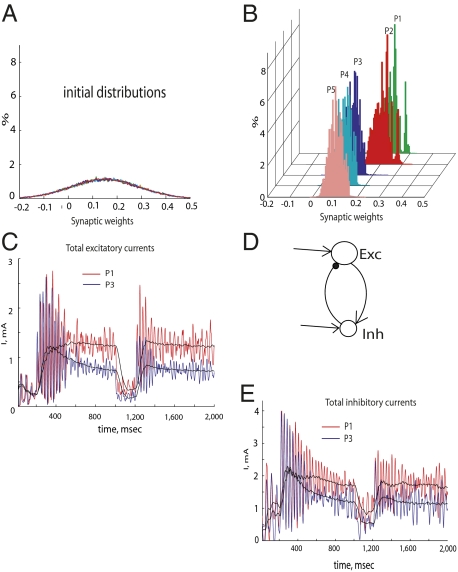Fig. 3.
(A) Initial weights of excitatory connections between neurons in populations P1–P5 were randomly chosen according to Gaussian distribution with a mean of 0.15 and SD of 0.1. Different colors represent different excitatory populations (P1–P5). (B) Distributions of the excitatory weights after stimulus presentation. The distributions of the weights are shown at the end of the first presentation of a stimulus (at time 1,000 msec). The distributions were separated into two groups: Connections to more active neurons in populations P1 and P2 increased (red and green, mean = 0.2), whereas connections to less active neurons in populations P3, P4, and P5 decreased (mean = 0.1). Further presentations of the stimulus to the network did not qualitatively change this separation. (C) Dynamics of the total excitatory synaptic currents entering neurons in populations P1 (red) and P3 (blue) and low-pass-filtered versions (black). The total current in population P2 neurons was similar to that in population P1 neurons, and currents to P4 and P5 neurons were similar to those in P3 neurons. During the first stimulus, the currents in populations P1 and P2 increased with time, whereas the currents in populations P3, P4, and P5 decreased and remained lower during the second presentation. (D) Schematic diagram of connections among excitatory and inhibitory neurons that result in synchronized activity. Excitatory neurons drive activity in the adjacent inhibitory neurons, which, in turn, synchronize spike initiation in the excitatory neurons. (E) Dynamics of the total inhibitory synaptic currents into neurons in populations P1 (red) and P3 (blue) and low-pass-filtered versions (black). Currents in population P2 neurons were similar to those in population P1 neurons, and currents in P4 and P5 neurons were similar to those in P3 neurons. Because of the homeostatic plasticity of the inhibitory connections, the currents to populations P3, P4, and P5 decreased with priming.

